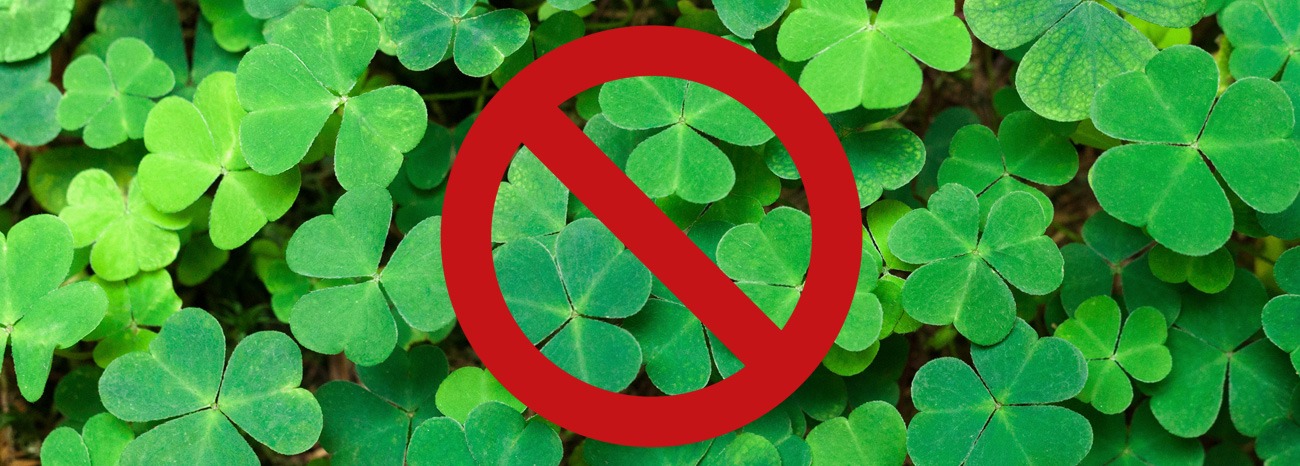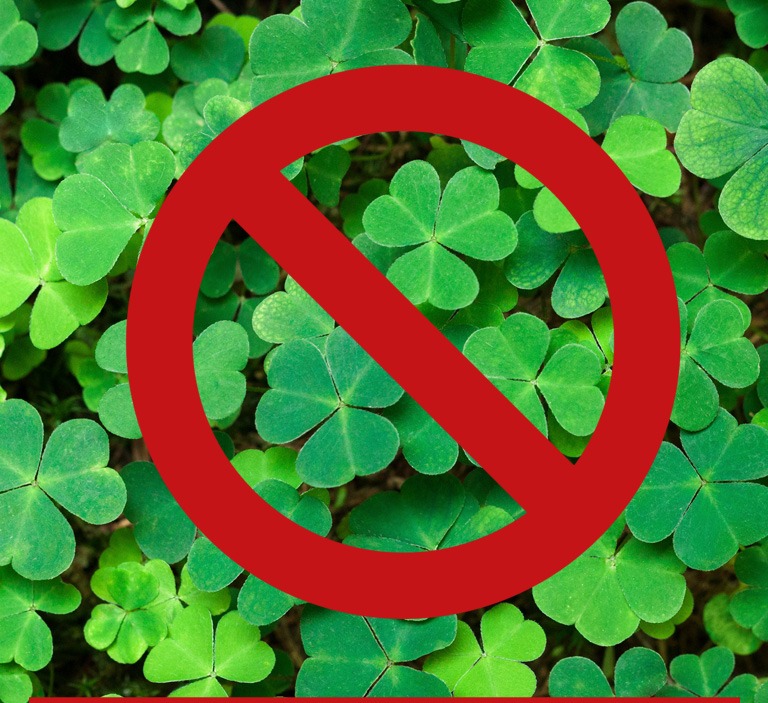If clover is spreading through your lawn, you’re not alone. Clover is one of the most common lawn weeds in Pennsylvania, thriving in areas where grass is thin or under stress. While some homeowners don’t mind it, most prefer a lush, green lawn without the white flowers of clover patches.
The good news is you have options. You can kill clover and keep it from coming back without destroying your lawn. Let’s go over what causes clover, how to spot it, the best ways to remove it—natural and chemical—with prevention strategies to stop it for good.
Why Is Clover Growing in Your Lawn?
Clover thrives in conditions that weaken turfgrass. If your lawn has any of the following issues, it creates the perfect environment for clover to move in:
- Low nitrogen: Grass depends on nitrogen for its thick, green carpet. The less nitrogen, the thinner your lawn. Because clover can create its own nitrogen it wins in nutrient-poor soil.
- Compacted soil: Dense, packed soil makes it hard for grass roots to grow deep. Clover’s shallow roots, on the other hand, don’t mind it at all.
- Short mowing: Cutting your grass too low removes shade, allowing sunlight to hit the soil, creating conditions clover seeds love.
- Water stress: Extremes in moisture, whether it’s from drought or excess rain, weaken turf and open up room for weeds like clover.
If your lawn is already showing signs of wear, visit our guide on how to fix a browning lawn for tips on grass recovery and resilience.
How to Identify Clover
Before you do anything, make sure what you’re dealing with is really clover. Here are the most common types:
- White clover (Trifolium repens): This is the most familiar variety, with small clusters of white or pale pink flowers and clumps of three round leaflets, often with a pale “V” shape on each.
- Micro-clover: This is a smaller variety of white clover that is sometimes mixed intentionally into eco-friendly lawns. It stays lower and blends into grass better but in traditional lawns it still stands out.
- Oxalis: Not truly a type of clover, but often mistaken for it with its heart-shaped leaves and bright yellow flowers. One way to know the difference? Oxalis leaves fold up at night, while clover leaves stay flat.
Correct identification helps you choose the right removal method since what works for clover might not work on other weeds.
Natural and Non-Chemical Ways to Remove Clover
If the patches of clover in your lawn seem manageable, try these methods to help reduce or eliminate it without chemicals:
Hand Pulling
- This method works best when the soil is damp, usually after rain or light watering.
- Grab clover at the base and pull slowly to remove the entire root.
- Reseed the area to prevent new clover from sprouting in the exposed soil. Learn how to do it right in our guide to overseeding bare spots and dead grass.
Smothering
- The smothering method works just like it sounds, blocking sunlight and starving the clover plant.
- Place cardboard, landscape fabric or a dark tarp over clover patches for 2–3 weeks.
- Once the area is clear, reseed with the turfgrass blend suited to your yard. (Not sure which one is best for your lawn? Consult our homeowner’s guide to lawn grass varieties in Pennsylvania.)
Mow Higher
- Set your mower height to 3-4 inches.
- Taller grass creates shade, which helps block clover from taking hold.
Organic and Low-Impact Clover Treatments
If you prefer to avoid chemical herbicides, try one of these eco-friendly options:
Corn Gluten Meal
- This acts as a pre-emergent herbicide that stops clover seeds from sprouting.
- It also adds slow-release nitrogen, which is ideal for strengthening turf.
- Apply early in spring for best results.
Iron-Based Weed Control
- Iron selectively dries out and darkens broadleaf weeds like clover without harming your lawn.
- This is safe for people and pets once it dries.
Vinegar-Based Spot Treatments
- Household vinegar or natural weed sprays can scorch clover leaves but they don’t always kill the roots.
- This is best when used on isolated patches with caution. Avoid spraying your grass so it doesn’t scorch along with the clover leaves.
When to Use Chemical Herbicides
If your lawn has clover all over, post-emergent broadleaf herbicides can offer fast and effective control. Look for products containing 2,4-D + MCPP + Dicamba. When used properly, these target clover without damaging your grass.
Application Tips:
- Apply on a calm, dry day (typically 60–85°F) during the time your grass is actively growing.
- Avoid windy conditions to prevent drift.
- Wear gloves, long sleeves and eye protection.
- Keep children and pets off the lawn until the treatment has dried (usually after 24 hours but check the label to be sure).
How to Prevent Clover From Coming Back
Clover thrives where grass is weakened, so building a thick, healthy lawn is the best long-term defense. Here’s how:
Feed Your Lawn Regularly
Use a balanced fertilization plan for your lawn to maintain steady nitrogen levels throughout the year. Not sure when to fertilize? Here’s our guide to the best time to fertilize your lawn.
Aerate and Overseed
Loosen compacted soil with annual core aeration and thicken your lawn by overseeding in the fall. It’s one of the best ways to prevent weeds from settling in.
Adjust Soil pH
Clover loves acidic soil. A pH test can reveal whether your soil needs lime. Aim for a range between 6.0 and 7.0. Learn how to test and correct your soil in our post on lime for a healthy lawn.
Skip the Guesswork with Total Green
Clover doesn’t stand a chance with professional care, and that’s exactly what our Total Green Plan delivers. With this plan, our experts will keep your lawn lush and healthy with:
- Soil testing and pH adjustments
- Customized fertilization and weed control
- Seasonal aeration and overseeding
- Year-round lawn health monitoring
Clover is persistent but your lawn can win the fight. Whether you’re going the DIY route or calling in the pros, the key is consistency and a lawn care plan that supports thick, healthy turf. We are here to help every step of the way. Call us today at 215.799.2016 or get started online for a free lawn evaluation.
FAQ
When is the best season to apply pre-emergent control for clover?
Early spring, when soil temps reach around 55°F. That’s when clover seeds begin to germinate.
Will clover harm my pets if they play in treated areas?
Clover itself is safe. If you’ve used any kind of treatment—organic or chemical—always wait until it dries before allowing pets back on the lawn.
Can micro-clover ever be beneficial as part of an eco-friendly lawn?
Yes. Some homeowners intentionally use micro-clover for its natural nitrogen benefits and drought resistance. It depends on your aesthetic and maintenance goals.
How quickly should I expect results after treatment?
Organic and hand-removal methods show results within days. Herbicides may take 7–14 days to begin working, with full results in 2–4 weeks.
What’s the difference between broadleaf and grassy weed control products?
Broadleaf weed killers target clover, dandelions and similar weeds. Grassy weed control products focus on crabgrass and other grass-like invaders. Always match the product to the weed type.


